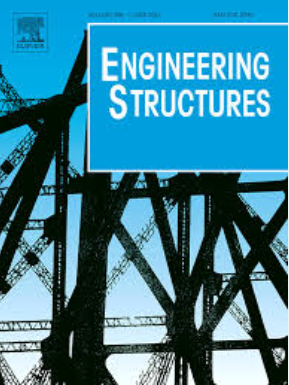高强度型钢包裹的超高强度混凝土梁受弯响应试验研究
IF 6.4
1区 工程技术
Q1 ENGINEERING, CIVIL
引用次数: 0
摘要
考虑型钢与混凝土在SRC结构中的正协同作用,本文研究了高强度钢增强UHPC (HSSRUHPC)梁的抗弯性能。采用不同的h型钢比(5.5 %、6.8 %和8.7 %)、钢结构(同心和偏心布置)和钢纤维体积分数(1 %、2 %和3 %)对6根HSSRUHPC梁进行了多点对称加载试验。结构性能进行了检查,包括破坏模式,载荷与挠度响应,载荷-应变行为和承载能力。试验结果表明,所有试件的破坏模式均为下加筋梁的典型弯曲破坏,尽管破坏仍呈现轻微脆性,峰值后承载值急剧下降。随着钢纤维添加量的增加,钢纤维具有良好的“桥接”效应,可以降低峰值荷载下的突然卸载,抑制裂纹的延伸,提高试件的承载力。试验结果还表明,HSSRUHPC梁的初始刚度和抗弯能力随h型钢比的增加呈线性提高,钢截面从质心向下移动有利于释放更多混凝土抗压强度,但不利于峰值后承载稳定性。最后,在平面截面假设的基础上,提出了一种考虑了UHPC拉力的重要贡献的HSSRUHPC梁极限弯矩计算的理论分析方法。测试数据以及从其他文献中排序的额外测试结果用于比较理论预测和测试值之间的区别。说明该方法具有良好的相关性,可以较高精度地估计HSSRUHPC梁的抗弯能力,为高强度材料加固SRC构件的设计提供参考。本文章由计算机程序翻译,如有差异,请以英文原文为准。
Experimental study on the flexural response of UHPC beams encased high-strength section steel
In consideration of the positive synergetic between H-shaped steel and concrete in SRC structures, this paper investigates the flexural behavior of high-strength steel reinforced UHPC (HSSRUHPC) beams. Six HSSRUHPC beams with different H-shaped steel ratios (5.5 %, 6.8 % and 8.7 %), steel configurations (concentric and eccentric placement) and steel fiber volume fractions (1 %, 2 % and 3 %) were tested under two-point symmetrical loading. The structural performance was examined involving failure pattern, load versus deflection response, load-strain behavior, and load carrying capacity. Experimental work indicated that the failure mode for all specimens occurred via the typical bending failure of the under-reinforced beams, although the failure still unfolded slightly fragility with an abrupt drop in post-peak bearing value. With the addition of steel fiber increasing, the sudden unloading at peak load could be degraded due to the superb “bridging” effect, which also inhibits the elongation of cracks and enhances the bearing capacity of specimens. The test results also signified that the initial stiffness and flexural capacity of HSSRUHPC beams are improved linearly with the H-shape steel ratios, and shifting the steel section downward from centroid is instrumental in discharging more concrete to resist compressive strength, whereas it exerts an adverse effect on post-peak bearing stability. Finally, a theoretical analysis methodology was proposed to reckon the ultimate moment of HSSRUHPC beams, which incorporated the momentous contribution of UHPC tensile force based on the plane section hypothesis. The test data along with additional test results sorted from other literature were used for comparing the distinction between theoretical predictions and test values. This method exhibiting good correlation is thus illustrated to estimate the bending capacity of HSSRUHPC beams with high accuracy, which provides a reference for the design of SRC members reinforced by high-strength materials.
求助全文
通过发布文献求助,成功后即可免费获取论文全文。
去求助
来源期刊

Engineering Structures
工程技术-工程:土木
CiteScore
10.20
自引率
14.50%
发文量
1385
审稿时长
67 days
期刊介绍:
Engineering Structures provides a forum for a broad blend of scientific and technical papers to reflect the evolving needs of the structural engineering and structural mechanics communities. Particularly welcome are contributions dealing with applications of structural engineering and mechanics principles in all areas of technology. The journal aspires to a broad and integrated coverage of the effects of dynamic loadings and of the modelling techniques whereby the structural response to these loadings may be computed.
The scope of Engineering Structures encompasses, but is not restricted to, the following areas: infrastructure engineering; earthquake engineering; structure-fluid-soil interaction; wind engineering; fire engineering; blast engineering; structural reliability/stability; life assessment/integrity; structural health monitoring; multi-hazard engineering; structural dynamics; optimization; expert systems; experimental modelling; performance-based design; multiscale analysis; value engineering.
Topics of interest include: tall buildings; innovative structures; environmentally responsive structures; bridges; stadiums; commercial and public buildings; transmission towers; television and telecommunication masts; foldable structures; cooling towers; plates and shells; suspension structures; protective structures; smart structures; nuclear reactors; dams; pressure vessels; pipelines; tunnels.
Engineering Structures also publishes review articles, short communications and discussions, book reviews, and a diary on international events related to any aspect of structural engineering.
 求助内容:
求助内容: 应助结果提醒方式:
应助结果提醒方式:


